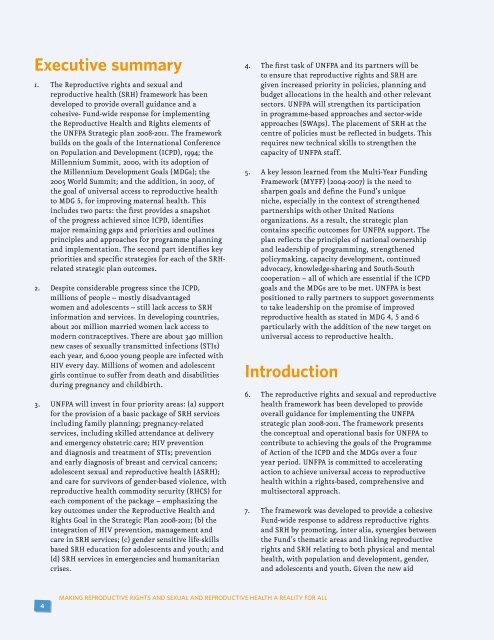Sexual and Reproductive Health Framework - UNFPA
Sexual and Reproductive Health Framework - UNFPA
Sexual and Reproductive Health Framework - UNFPA
Create successful ePaper yourself
Turn your PDF publications into a flip-book with our unique Google optimized e-Paper software.
Executive summary1. The <strong>Reproductive</strong> rights <strong>and</strong> sexual <strong>and</strong>reproductive health (SRH) framework has beendeveloped to provide overall guidance <strong>and</strong> acohesive- Fund-wide response for implementingthe <strong>Reproductive</strong> <strong>Health</strong> <strong>and</strong> Rights elements ofthe <strong>UNFPA</strong> Strategic plan 2008-2011. The frameworkbuilds on the goals of the International Conferenceon Population <strong>and</strong> Development (ICPD), 1994; theMillennium Summit, 2000, with its adoption ofthe Millennium Development Goals (MDGs); the2005 World Summit; <strong>and</strong> the addition, in 2007, ofthe goal of universal access to reproductive healthto MDG 5, for improving maternal health. Thisincludes two parts: the first provides a snapshotof the progress achieved since ICPD, identifiesmajor remaining gaps <strong>and</strong> priorities <strong>and</strong> outlinesprinciples <strong>and</strong> approaches for programme planning<strong>and</strong> implementation. The second part identifies keypriorities <strong>and</strong> specific strategies for each of the SRHrelatedstrategic plan outcomes.2. Despite considerable progress since the ICPD,millions of people -- mostly disadvantagedwomen <strong>and</strong> adolescents -- still lack access to SRHinformation <strong>and</strong> services. In developing countries,about 201 million married women lack access tomodern contraceptives. There are about 340 millionnew cases of sexually transmitted infections (STIs)each year, <strong>and</strong> 6,000 young people are infected withHIV every day. Millions of women <strong>and</strong> adolescentgirls continue to suffer from death <strong>and</strong> disabilitiesduring pregnancy <strong>and</strong> childbirth.3. <strong>UNFPA</strong> will invest in four priority areas: (a) supportfor the provision of a basic package of SRH servicesincluding family planning; pregnancy-relatedservices, including skilled attendance at delivery<strong>and</strong> emergency obstetric care; HIV prevention<strong>and</strong> diagnosis <strong>and</strong> treatment of STIs; prevention<strong>and</strong> early diagnosis of breast <strong>and</strong> cervical cancers;adolescent sexual <strong>and</strong> reproductive health (ASRH);<strong>and</strong> care for survivors of gender-based violence, withreproductive health commodity security (RHCS) foreach component of the package – emphasizing thekey outcomes under the <strong>Reproductive</strong> <strong>Health</strong> <strong>and</strong>Rights Goal in the Strategic Plan 2008-2011; (b) theintegration of HIV prevention, management <strong>and</strong>care in SRH services; (c) gender sensitive life-skillsbased SRH education for adolescents <strong>and</strong> youth; <strong>and</strong>(d) SRH services in emergencies <strong>and</strong> humanitariancrises.4. The first task of <strong>UNFPA</strong> <strong>and</strong> its partners will beto ensure that reproductive rights <strong>and</strong> SRH aregiven increased priority in policies, planning <strong>and</strong>budget allocations in the health <strong>and</strong> other relevantsectors. <strong>UNFPA</strong> will strengthen its participationin programme-based approaches <strong>and</strong> sector-wideapproaches (SWAps). The placement of SRH at thecentre of policies must be reflected in budgets. Thisrequires new technical skills to strengthen thecapacity of <strong>UNFPA</strong> staff.5. A key lesson learned from the Multi-Year Funding<strong>Framework</strong> (MYFF) (2004-2007) is the need tosharpen goals <strong>and</strong> define the Fund’s uniqueniche, especially in the context of strengthenedpartnerships with other United Nationsorganizations. As a result, the strategic plancontains specific outcomes for <strong>UNFPA</strong> support. Theplan reflects the principles of national ownership<strong>and</strong> leadership of programming, strengthenedpolicymaking, capacity development, continuedadvocacy, knowledge-sharing <strong>and</strong> South-Southcooperation – all of which are essential if the ICPDgoals <strong>and</strong> the MDGs are to be met. <strong>UNFPA</strong> is bestpositioned to rally partners to support governmentsto take leadership on the promise of improvedreproductive health as stated in MDG 4, 5 <strong>and</strong> 6particularly with the addition of the new target onuniversal access to reproductive health.Introduction6. The reproductive rights <strong>and</strong> sexual <strong>and</strong> reproductivehealth framework has been developed to provideoverall guidance for implementing the <strong>UNFPA</strong>strategic plan 2008-2011. The framework presentsthe conceptual <strong>and</strong> operational basis for <strong>UNFPA</strong> tocontribute to achieving the goals of the Programmeof Action of the ICPD <strong>and</strong> the MDGs over a fouryear period. <strong>UNFPA</strong> is committed to acceleratingaction to achieve universal access to reproductivehealth within a rights-based, comprehensive <strong>and</strong>multisectoral approach.7. The framework was developed to provide a cohesiveFund-wide response to address reproductive rights<strong>and</strong> SRH by promoting, inter alia, synergies betweenthe Fund’s thematic areas <strong>and</strong> linking reproductiverights <strong>and</strong> SRH relating to both physical <strong>and</strong> mentalhealth, with population <strong>and</strong> development, gender,<strong>and</strong> adolescents <strong>and</strong> youth. Given the new aid4MAKING REPRODUCTIVE RIGHTS AND SEXUAL AND REPRODUCTIVE HEALTH A REALITY FOR ALL
















